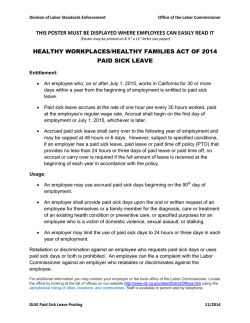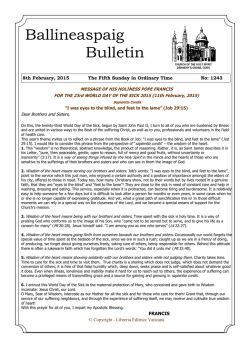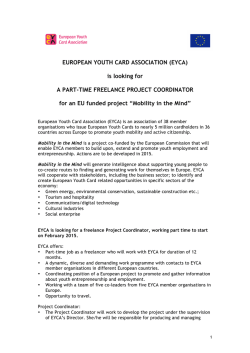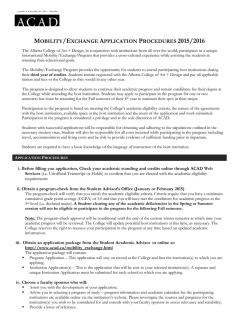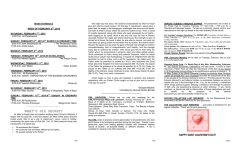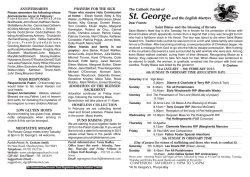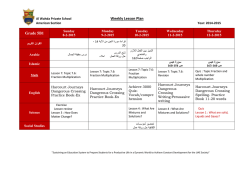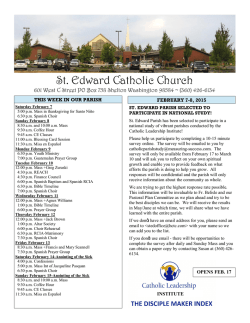
The mobility of the sick - The Transport and Society Network
The mobility of the sick: perverse organizational premises Margaret Grieco, Professor of Transport and Society, TRI, Edinburgh Napier University email: [email protected] Identity • The images provided today are of my parents as they sought to maintain their mobility even whilst sick in their final years. The remit • The remit for today’s presentation was to develop and advance a critical appreciation of modern organizational forms and principles. My critical appreciation of modern forms of organization, their performance, affordances and failures has largely been developed in the intersection between my very vibrant working class family (most particularly my parents, Mary and Hughie Hossack, both of whom died this year within eight weeks of one another) and my professional experience and training. Developing critical voice • I understood very early that the shape of the world experienced by my family differed greatly from both the professional account of the world and the personal experience of professionals in that world. My critical voice makes use of my professional training to better relay the experience of the world as lived by my parents and their social and kin networks in their journeys to death Inclusive critical organizational theory • it is a step in the direction of inclusive critical organizational theory and a beginning to the recognition that unless end-users are properly consulted and afforded full participation in any system or organization the failings of that system are likely to remain concealed and disguised from policy makers and operators even as the population of end-users grows its own knowledge base of the gaps in provision and the errors in performance. Mobility and the end user • Extendable contours of end user participation in the design of mobility • Easing mobility and the extension of wellbeing Expert provenance • Let me start by providing some provenance in terms of my professional standing on research into health system and their related mobility dimensions. At the ESRC Work Organisation Research Centre at Aston University in the 1980s, I had responsibility for researching hospital design and within that remit I researched the early attempts to improve the coordination of patient transport systems within the NHS, most particularly at Bury St Edmunds. In the late 1980s whilst researcher at the Transport Studies Unit, University of Oxford, I researched low income journey patterns in Liverpool including difficulties experience on health journeys. In the 2000s, whilst Professor of Transport and Society at Napier University and in conjunction with the Transport Studies Unit of the University of Oxford, I undertook consultancy on health transport provision in Oxfordshire. Also in the 2000s, I undertook action research with communities in Newcastle on the difficulties they experienced on health journeys. Outside the normal constraints • This experience of health system and hospital research has stood me in good stead these last years as both my parents increased the level of their interaction with the NHS. Both have recently died and I am in the position of having been witness to their experiences of the patient transport system without having any of the usual constraints on confidentiality or access surrounding social science research in the very heavily bureaucratized contemporary period. In this presentation, I want to set out some of the insights that my privileged position as daughter to my valiant parents afforded. Opening the door on a closed evidence system • I do this to open debate outside of the confines of our current understanding of the evidence based system where what constitutes evidence is insufficiently problematised and where those agencies commissioning the research are very often the immediate beneficiaries of the evidence arrived it. The permissions necessary to produce evidence outside of the dominant funding framework of government linked and financed research are themselves problematic and gaining them creates the alert which very often precluded the emergence of the evidence. In this context, there has been the use of the new communication technologies by social movements of patients relatives as in the case of Staffordshire’s hospital - such social movements have raised alerts but are poorly accompanied by professionals failing to examine their stance and distance from the funding agencies. Mobile networks • Achieving health through active participation The mobility of the sick, a perverse organizational premise • Today I want to take this audience inside the lived experience of Britain’s low income and vulnerable sick population. I want to start with installing the understanding that inside a system declared to be dedicated to the sick and ‘intended’ to ensure that those of low income have access to health facilities, there are perverse organizational premises in position. Placing health beyond reach • The first perverse organizational premise that I want to address today is ‘the mobility of the sick’ itself. Through an organizational process of the centralization of treatment facilities which is an outcome of the intersection between land values and the desire to achieve economies of scale, we have come to a position where treatment is concentrated in large scale institutions which are very often located at points that are not convenient for those on low income and increasingly are associated with the spreading of disease as well as with curing disease. Insistence on the supersize • The insistence on economies of scale and super-size, centralized facilities can in this context be viewed fairly easily as a perverse organizational premise. Facilities which were historically located at the centre of populations have now been moved to points on the periphery because of greater space and lower land costs without adequate attention being paid to the transport geography of health to ensure that these facilities are indeed readily reachable. Sustaining sociability • Maintaining the face to face Measuring stress against mode of access • The models used to determine accessibility to these facilities bear little relation to the lived experience of travel stress and barriers to accessibility encountered on both routine and crisis journeys to health facilities. The transport of the sick to the place of treatment could be properly integrated into the provisions of the National Health System but it is undoubtedly not. Mobility of the patient versus mobility of the treatment • The level of transport system coverage, and indeed the audit of transport system coverage, is very weak and is in the process of further weakening. Let me use this space today to indicate that requiring mobility from the sick is from the start a questionable principle – so ingrained is this ‘modern’ principle that we actually have no policy discussion of the extent to which equipment might be better designed to afford a greater level of mobile treatment. Designing the transport geography of health • That different configurations of the relationship between illness and mobility are possible has received no substantial policy attention. There is no policy discussion of how better to organize the transport geography of health – the discussion rests at the level of providing transport for the extreme cases and as we shall see in the journey we take in this presentation today even here the lived experience of hospital transport is an unnecessary stressful and frequently undignified one. Evasion of the public gaze • In the journeys of my parents to their deaths, there was the precious professional opportunity to have access to these dimensions and to witness their consequences. Under normal circumstances ethical permissions would have had to be obtained and these ethical permissions provide the alert and alarm mechanisms for the evasion of public gaze over what are publicly funded processes. A silent policy principle • Starting from the perversity of requiring mobility of the sick in circumstances where the greater mobility of the professionals and of equipment could provide a lesser transport load and burden on those who are already vulnerable, the silent policy and vital premise of the contemporary National Health Service is that the family will shoulder the transport burden of the mobility of the sick and caring low income families do so in abundance. Discourse and debate • Ensuring network support (not) Designing in access at health facilities • Oncology patients at one of Britain’s leading hospitals in their terminal stages are not entitled to hospital transport – they can claim travel expenses but not for taxis (the rules can vary from hospital to hospital on who precisely is entitled to hospital transport). Public transport systems are not designed so that public transport vehicles pick patients up and put them down at reception points in a hospital which afford ready access for the sick to facilities. A journey in a taxi or a private car often affords the sick safer access to the hospital than can be accomplished by any combination of public transport – public transport is designed in the main for the able bodied even where it is a service to a hospital. Disattendance to distress • This is surely perverse as it stands and clearly fixable but why have we permitted this obvious functional test of system performance to be neglected - the answer lies in the disattendance to the distress of those forced to use the system through the absence of other options and the reduced visibility of the fault through the innovativeness of those assisting the sick and vulnerable often at considerable and unrecorded cost to themselves both in terms of stress and in terms of finance. Paying the penalty for caring • In a system where we force the mobility of the sick without providing for transport arrangements which respect dignity and reasonable ease of access, a new perverse organizational principle has found place – that is the payment for the use of hospital car parks. Hospital car parking is now a major revenue earner with the consequence that family and friends not only provide the critical link in providing access to hospitals they pay major financial penalties for doing so. Information technology and bona fide parking • Claim back schemes are weak and not well advertised and the development of an administrative scheme which ensured that those parking on hospital premises have bona fide reasons for doing so is not a difficult organizational step in these times of new technology but the revenue drive is perverting the publicly acclaimed goal of hospital functioning. The absence of compassion • The patient transport systems of the NHS are not well researched, have been inadequately evaluated and are not presented in an administrative form which makes them accessible to end user scrutiny or indeed end user use. Where patient transport is provided the dominant focus is on achieving notionally high levels of system efficiency through the bureaucratized scheduling of patient journeys. Waiting lists, disrupted lives • This bureaucratized scheduling occurs in a context where there is a lack of effective coordination between agencies and in which elderly citizens have to stand ready to be picked up for their journey at a time well before their appointments and where the vehicle that is supposed to carry them may actually arrive after their appointment time has passed. Where the authorized patient transport vehicle is late, the patient will still receive treatment but at a very delayed time. Slack for the system, distress for the patient • This accommodation between agencies creates slack which is useful to the patient transport system operators but fails to appreciate the travel stress and disruption to the lives of the elderly ill that it occasions. Increasing stress, accentuating illness • This lack of patient control over the time windows of their transport and treatment does not fit well with the expressed service character of the NHS and understandings of patients’ charters and patients’ control over their health circumstances and rests on a perverse organizational premise. The value of time of the nonworking receives a lower assessment than that of the able-bodied and working, however, the level of stress that lack of control over a journey inflicts on the vulnerable has consequences for the pattern of treatment outcomes. Lengthened journeys, reduced dignities • Furthermore, in this context of lack of control over the time windows involved in their transport and treatment, the elderly are placed into inconvenience by the lengthened duration of journeys because of the logistic practices of filling a vehicle en route to a hospital or treatment centre. The journey is all too often not a direct one with all the attendant pressures of a full bladder that such lengthened journeys occasion. Clearly under such conditions patient travel stress is heightened – studies of these logistic practices and the consequences of these practices are missing from the performance evaluation of the health system. Controlling journey times • Ensuring dignity Fully loaded • A time-space constraint analysis of the mobility of the sick that the present institutional interaction between patient transport systems and health system requires is long overdue. This pressure to ensure that vehicles are fully loaded can be readily viewed as inappropriate to the function of providing elderly patients with readily accessible treatment in dignity. Transporting the sick: delivering health • The present arrangements can rapidly be seen to be based in perverse organizational premises: the logistic organization appropriate for the transportation of goods, we must recognize, is not necessarily appropriate for people. Failure to provide and failure to communicate • The present patient transport system does not guarantee the elderly sick the availability of patient transport systems. Elderly oncology patients with terminal sickness, as we have already remarked, are responsible for their own transport to treatments. Inside of this poorly coordinated health transport provision system with its highly evident gaps in provision, the failure to communicate patients’ conditions and special needs for transport occurs all too often. A modern ‘Babel’ • Despite the communication affordances of new information communication technologies, practices around elderly patients remain babelesque – notes are not passed on from the professionals involved at one stage of a health journey to those who are meant to take responsibility for the next or if they are they are misplaced. There are very poor handover practices and no ‘chain of evidence’ or ‘chain of information’ protocols. Citizen accounts of such failure are plentiful and radio talk shows such as that hosted by Radio Cambridge provide ample account for the systematic organizational science research on the matter to begin. Accommodating escorts • Discussions of whether the mobility of the sick or the mobility of the service provider is what is required in an aging society have not yet begun but there are sensible and critical discussions to be had on this topic. Similarly, the entitlement to be escorted by a relative in a patient transport vehicle is not recognized and this discussion is one that should be had as a matter of urgency in a context where the elderly person or any sick person may need support in providing and maintaining an accurate narrative of their ailment and condition. The perverse premise of efficiency • The time-space constraint of scheduling vehicles fully loaded with the sick works against the preservation of the necessary space for what is surely the necessary escort if both accuracy and compassion are to be respected. It is a perverse organizational premise to assume that efficient information handovers are in play: twice in two nights I found myself having to inject my diabetic mother in one of Britain’s leading hospitals because of inadequate information transfer procedures – and there were many other instances of such failure around her treatments and of those known to her and within her social network. Patient control • In witnessing, a persistent set of logistic and failures of compassion in the treatment of my elderly but vibrant parents, it seemed to me that there must be better ways of achieving coordination around the needs of the elderly sick which did not maximize their scheduling load whilst simultaneously providing scheduling flexibilities to the system – and I think that I see a path forward which is worthy of policy attention. There is a need for a person based coordination tool or handset which is within the ownership of the patient - such a handset could hold the patient’s records, provide real time information on patient transport systems routing and pick up times, provide an alert where there are failures to attend to the specific needs of the patient and, as importantly, provide a record of such failures. The bureaucracy of bereavement • Before leaving the time space constraint framework experienced by elderly patients of the NHS and the perverse organizational premises which define and accompany it, I want to draw attention to the complexity of scheduling and scheduling overload experienced by elderly patients in the bereavement context. In the present, the bureaucracy attending bereavement maximizes the resource uncertainties of the bereaved (despite the one off payment for bereavement of a spouse, the remaining partner is subject to a set of procedures of reassessment for benefit entitlements requiring appointments and detailed provision and representation of information already held by the state). Accentuated vulnerability • At this point in the life cycle, and given the likely health difficulties attending the surviving elderly partner, resource uncertainties should be minimized and not to do so is at odds with stated governmental policies of social inclusion. The current bureaucracy attending bereavement accentuates the vulnerability of the elderly sick – and clearly adds to the level of time space constraints experienced by this vulnerable group by increasing the density of the scheduling load. Fragmentation of care • Let me leave this discussion with the understanding communicated to me by expert medical practitioners in one of the country’s leading specialist hospitals – the health transport systems do not fit well with the culture they would prefer to exist around their patients and their treatment but they are powerless to make the changes even within their own environment. The fragmentation of authority and function leaves the medics with no power to produce in the ancillary services the culture and practice that would best benefit their patients. Oxygen constraints • The medic only has control at the point of treatment which means that respiratory patients who are oxygen dependent can be left for considerable lengths of time without being provided with the transport they have booked – and this in a context where patients have to bring their own oxygen with them. Clearly, a situation of extreme time-space constraint produced through the operation of perverse organizational premises and one that is routinely present in our society without an accurate record being taken, called for or acted upon. Time for change • Time for change, time for measurement, time for social action, time for policy action, time to attend to distress and to properly involve the end user in determining the pattern of provision: time that organizational research took a critical path to resolving the paradox of requiring the sick to be mobile. Charting and correcting perverse organizational premises • In conclusion, we have taken a troubling journey around the undiscussed character of routine constraints and barriers experienced by the vulnerable in the health context. Along the journey we have seen that the relationship between dignity, bodily functions and time space dynamics are insufficiently considered and actively disattended to with highly negative consequences for policy formulation. Policies are required which compensate for existing and measureable vulnerabilities and a process driven adjustment to existing practices, provisions and facilities rather than bureaucratised standardization is needed. If mobility is required of the sick then appropriate transport arrangements must be made and must be viewed as part of the treatment system not as an ad hoc add on; if social network dynamics are to be used in the transport of the sick, then policy must be explicit on it rather than silent and must accommodate it by rethinking the current pattern of penalties for such necessary participation. Raising challenge • Currently, research structures have become overly corporate with the size of an institute’s budget and the payment of professionals for supposedly evidence based research becoming the hallmarks without the imperatives to service the vulnerable and to ensure that evidence is not overly determined by dominant funders being respected. The power to speak over the experience of the end user has its own time space characteristics – the location of the presentation of evidence has a consequence for its form. Presenting evidence in a location, framework and forum where end users can raise challenge is critical to the integrity of the policy process but these conditions are rarely met in the present policy environment. Revealing under use and under representation • Data needs to be collected in a way and with the purpose of revealing patterns of under-use and under-representation of services and facilities by the vulnerable and not simply collected to confirm assumptions of patterns of competent performance. The high quality framing of issues must concern itself with revealing the previously hidden – perverse organizational premises must be challenged. A time space constraint approach leads us towards more fundamental practices of process investigation rather than a parading of apparent patterns of outcomes and this in turn leads us towards a practice of process correction. Identifying time space constraints represents a woefully neglected element of the sickness and mobility discourse and it is time for the correction of this neglect with detailed analysis of time space constraints across the range of social action and health. Such an analysis will rapidly highlight the perverse organizational premises currently in play. The end user The need for active advocacy
© Copyright 2026
